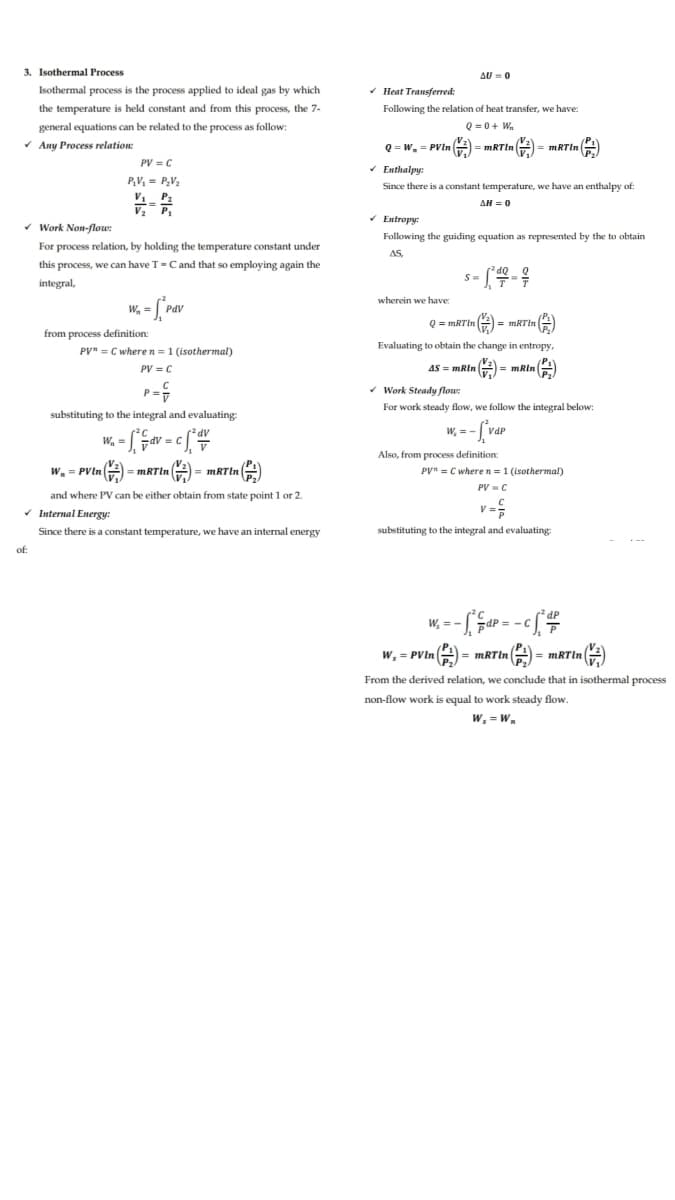Derive the seven general property equation of the following thermodynamics processes: a. ISOMETRIC PROCESS - Any Process relation - Work Non-flow - Internal Energy - Heat Transferred - Enthalphy - Entropy - Work Steady flow refer with the picture. Show all the detailed explanation
Derive the seven general property equation of the following thermodynamics processes: a. ISOMETRIC PROCESS - Any Process relation - Work Non-flow - Internal Energy - Heat Transferred - Enthalphy - Entropy - Work Steady flow refer with the picture. Show all the detailed explanation
Principles of Heat Transfer (Activate Learning with these NEW titles from Engineering!)
8th Edition
ISBN:9781305387102
Author:Kreith, Frank; Manglik, Raj M.
Publisher:Kreith, Frank; Manglik, Raj M.
Chapter5: Analysis Of Convection Heat Transfer
Section: Chapter Questions
Problem 5.12P
Related questions
Question
Derive the seven general property equation of the following thermodynamics processes:
a. ISOMETRIC PROCESS
- Any Process relation
- Work Non-flow
- Internal Energy
- Heat Transferred
- Enthalphy
- Entropy
- Work Steady flow
refer with the picture. Show all the detailed explanation

Transcribed Image Text:3. Isothermal Process
AU = 0
Isothermal process is the process applied to ideal gas by which
- Heat Transferred:
the temperature is held constant and from this process, the 7-
Following the relation of heat transfer, we have:
general equations can be related to the process as follow:
Q = 0+ W.
* Any Process relation:
Q = w, = PVin A = MRTIN = mRTin A
| =
PV = C
* Enthalpy:
P,V = P,V2
Since there is a constant temperature, we have an enthalpy of
V P2
V2 P,
AH = 0
* Entropy:
* Work Non-flow:
Following the guiding equation as represented by the to obtain
For process relation, by holding the temperature constant under
AS,
this process, we can have T=Cand that so employing again the
integral,
wherein we have:
W, = [Pav
Pdl
Q = mRTin #) = mRTIn )
from process definition:
PV" = C where n=1 (isothermal)
Evaluating to obtain the change in entropy,
PV = C
AS = mRin #)
|= mRin
P =
- Work Steady flow:
For work steady flow, we follow the integral below:
substituting to the integral and evaluating:
W, = -
W. =
AP:
dV =
Also, from process definition:
w. = PVine-
PV" = C wheren =1 (isothermal)
= mRTin
PV =C
and where PV can be either obtain from state point 1 or 2.
v Internal Energy:
V =
Since there is a constant temperature, we have an internal energy
substituting to the integral and evaluating:
of:
² dP
W, = -
w, = PVIn
= MRTIN
mRTIn 2
From the derived relation, we conclude that in isothermal process
non-flow work is equal to work steady flow.
W, = W.
Expert Solution
This question has been solved!
Explore an expertly crafted, step-by-step solution for a thorough understanding of key concepts.
Step by step
Solved in 2 steps with 2 images

Knowledge Booster
Learn more about
Need a deep-dive on the concept behind this application? Look no further. Learn more about this topic, mechanical-engineering and related others by exploring similar questions and additional content below.Recommended textbooks for you

Principles of Heat Transfer (Activate Learning wi…
Mechanical Engineering
ISBN:
9781305387102
Author:
Kreith, Frank; Manglik, Raj M.
Publisher:
Cengage Learning

Principles of Heat Transfer (Activate Learning wi…
Mechanical Engineering
ISBN:
9781305387102
Author:
Kreith, Frank; Manglik, Raj M.
Publisher:
Cengage Learning